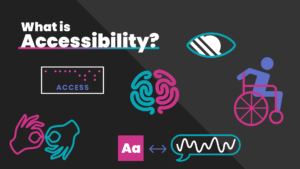
What Is Accessibility?
In this blog post we will define accessibility as well as provide you with concrete tips and food for thought. First, think of your customer base. How are your customers interacting with your product or service? Chances are, nearly 15% of your customers have some kind of disability.
And if it’s any lower than that, you’re missing out on a significant market. There are over 42 million Americans with disabilities, according to Pew Research Center.
To reframe the initial question: How accessible is your product or service? Are all of your customers able to access and utilize your product or service? If not, there are two questions to ask:
First, what barriers exist for them?
Second, what can you do to remove those barriers?
Read our “State of Accessible Marketing” 2024 Report here
Let’s Define Accessibility
When we talk about accessibility, it’s essential to think about the design and the implementation of the product or service and how they cater to the diverse needs of individuals. Regardless of how you define accessibility, the end goal should always be to ensure that everyone, regardless of abilities or disabilities, can access and utilize them.
Get the Accessible Marketing Checklist here
An accessible website means that the formatting of codes and heading styles are used appropriately. It means that the color contrast passes the WCAG AA. It means keyboard accessible features are enabled.
Accessible content includes captions, transcripts, alt-text, image/video descriptions. It avoids potential triggers for those with sensory sensitivities.
An accessible environment takes in consideration of wheelchair users, optimal lighting for best visual accessibility, and sound level for the least hearing barriers. There are clear signs indicating where to go.
Here are some fantastic accessibility tips on Web Development and Content Creation.
Why Accessibility Matters
The above examples are only a handful of picks from what should be a holistic approach. When you choose to make accessibility a core value, you are embracing an intentional practice to offer something that can be experienced without barriers. Not only that, you are also joining in on the movement to remove barriers that exist in our society.
Inclusivity Leads to Innovation
Embracing accessibility fosters an environment of innovation. By considering the diverse needs of our audience, we encourage creative problem-solving that goes beyond the status quo. This not only benefits individuals with disabilities but enhances the overall user experience for everyone.
Expanding Audience Reach
An accessible approach to marketing ensures that our messages reach a wider audience. By incorporating features such as subtitles, sign language interpreters in video content, and descriptive text in visuals, we make our marketing materials accessible to the deaf and hard of hearing community, broadening our impact.
Building Trust and Loyalty
Inclusivity builds trust. When individuals feel seen and heard, they are more likely to connect with and trust a brand. Our commitment to accessibility is not just a business strategy; it’s a reflection of our values, creating a foundation for lasting relationships with our clients and customers.
Contact us to work together on making your marketing accessible today
Conclusion
In the ever-evolving landscape of marketing, our deaf-owned firm champions accessibility as a fundamental aspect of our mission. By embracing inclusivity, we not only enrich the experiences of individuals with disabilities but also contribute to a more diverse and vibrant digital community. Accessibility is not just a checkbox; it’s a commitment to creating a world where everyone has an equal opportunity to engage, connect, and thrive.


